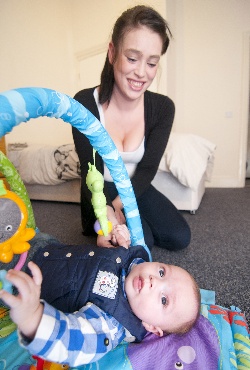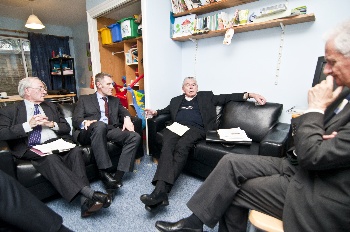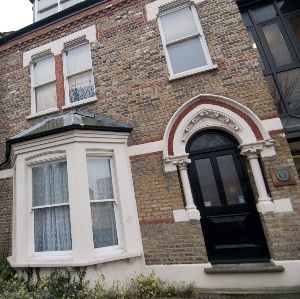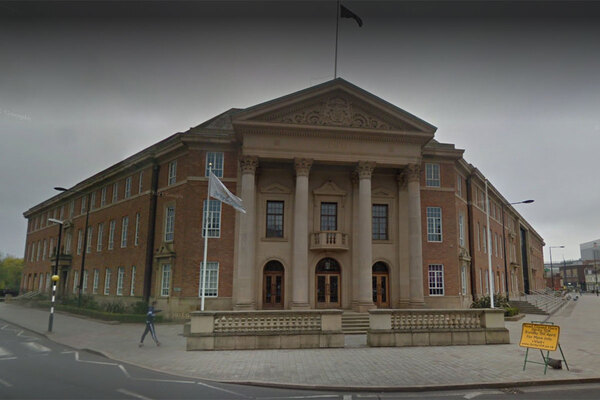The history boys
Fifty years ago a new housing association bought its first property for £3,500. Today, that organisation manages 70,000 homes and employs more than 1,000 people. Simon Brandon meets London & Quadrant’s founders and current leaders to discover what drove that first purchase and find out what challenges lie ahead
Quite a few things began in 1963: the Beatles’ recording career, the Daleks’ world domination, and even the poet Philip Larkin’s sex life.
It was a big year for new beginnings in social housing too. London & Quadrant, the UK’s second largest housing association, was born, as was its current chief executive, David Montague - about 200 yards from his organisation’s first office in Deptford, south east London.
The half-century celebrations have begun with what must be a unique event: L&Q’s founders, the Reverend Dr Nicolas Stacey and retired publisher Gospatric Home, are sitting down with Mr Montague and his chair, Turlogh O’Brien, in the very first property acquired by Quadrant Housing Association.
This small terraced house sits on a quiet and unprepossessing street on top of a hill in Woolwich. It is still owned by L&Q and has fulfilled a social brief ever since; today the organisation leases 2 Wrottesley Road to Catch 22, an organisation that provides accommodation for young, single mothers and their babies.

Catch 22 resident Shakira Daniels and her son Ryan-Kai
Neither of the original founders is today involved directly with the organisation they created. Rev Stacey took up a senior post at Oxfam in 1968, while Mr Home - who remained on the board until 2000 - says he has not been inside this landmark property in the 50 years since it was first let as a social home. ‘Extraordinary’ is a word he uses often and with delight during our meeting.
The original organisation was named Quadrant - a naval term in tribute to Woolwich’s maritime history - and only became London & Quadrant in 1973, following a merger with London Housing Trust. L&Q today is a very different beast to the organisation founded by activists and volunteers half a century ago; last year it turned over £370 million and employs around 1,100 staff.
‘We never dreamed of more than 40 employees,’ says Mr Home, a genial, smartly dressed man who turned 80 in February this year. ‘We were glad to have one or two helpers.’
‘It is so marvellous to see this little acorn grown into a wonderful oak,’ says Rev Stacey. Even seated, the 85-year-old clergyman is a large presence in the room. This is a man who managed to start a housing association from nothing and all eyes turn to him as he tells the story of how he planted the acorn and watched it grow into the organisation it is today - one that manages 70,000 properties across London and the south east. ‘We did make that possible,’ he states with typical forthrightness.
Housing need
In 1963, Rev Stacey was Rector of Woolwich. ‘More people came to see me about housing problems than any other,’ he recalls.
Beyond the immediate need for housing, he understood the consequences of its shortage. In his autobiography, Who Cares?, published in 1971, he wrote: ‘Daily I saw the broken homes, the mental illness, the alcoholism that resulted from London’s housing problem.’
Mr Home, meanwhile, chaired the 1958 Club, a dinner society comprised of young bachelors working in the City of London. ‘We were the yuppies of our generation,’ he says. The club met regularly at Quaglino’s, a restaurant in London’s west end, to hear talks by invited guests.
‘I suggested to the club that we should move on from filling our tummies and use the corporate energy we had to do something useful,’ Mr Home says. With that in mind he invited Rev Stacey - who he describes as a ‘stormy petrel of the clerical world… with a reputation for speaking his mind’ - to give a talk on homelessness in Woolwich and his work with homeless people there.
Afterwards, Mr Home asked Rev Stacey if he could think of anything worthwhile for his club members to do. ‘[Later] he rang me up and said - “the idea is to form a housing association”. My immortal reply was: “What’s that?”.’
But it was a subsequent visit to a homelessness hostel in Plumstead, near Woolwich, that ‘sealed the deal’, as Mr Home puts it.
The hostel, managed by London County Council (the forerunner to the Greater London Council), made a striking impression. Rev Stacey recalls ‘an all-pervading smell of cabbages and stale urine’.
‘That [visit] really got into our hearts,’ Mr Home remembers. ‘After that we moved very quickly - we formed a committee and raised £64 through 32 shares of £2 each. We started with nothing.’

Fellow resident Julie Rice and her son Aden
Opportunity knocks
In 1963, 150,000 households - around half a million people - were on the housing waiting lists of all London boroughs (in 2011 there were 367,000 households on housing waiting lists in the capital). Ongoing slum clearances were decreasing the available housing stock by replacing high-density homes with larger properties. Those households displaced by the clearances or other redevelopment were given priority for new housing over those living in penury.
But Quadrant’s founders had spotted an opportunity in London’s early 20th century two-storey terraces. These could be bought and converted into two or three flats for around £3,500 (around £60,000 in today’s money). This was, Rev Stacey claims, around half what it cost the council to build a new two-bedroom flat.
The Woolwich house where we meet today was their first conversion. Mr Home recalls their first tenant, a homeless woman called Mrs Cobb who provided early evidence that his fledgling organisation was doing actual good.
‘She had the top-floor flat,’ he says. ‘I saw her again one month after she moved in, and I could see the difference already.’
In 1964, Quadrant bought and converted two more properties, and a further four the year after that. Each was purchased from the London Borough of Woolwich, which was absorbed into the Borough of Greenwich a year later in 1965. The GLC grants with which Quadrant did so only accounted for 90 per cent of the value. The remaining 10 per cent had to be raised elsewhere, and for a small charity this was an onerous burden. ‘It felt as if the brakes were always on,’ says Mr Home.
But in December 1965, Rev Stacey managed to persuade the GLC to loan Quadrant the full 100 per cent of the value of new properties, and its development programme skyrocketed. ‘The GLC was the goose that was going to lay the golden egg,’ he recalls. ‘I cannot believe that its feathers had ever been stroked so lovingly, or its officials smiled at so sweetly as they were by me.’
By April 1972 Quadrant owned and managed 1,230 homes and was expanding at the rate of 400 a year.
Breakthrough moment
The foundations for today’s 70,000-home landlord had been laid. But steering Quadrant through its infancy was, as its founders remember fondly, a world away from running today’s multi-million pound business.

Reverend Dr Nicolas Stacey talks to Gospatric Home (left), David Montague (centre left) and Turlogh O’Brien (right)
The founders’ recollections of Quadrant’s beginnings are redolent with seat-of-the-pants entrepreneurship and a bit of cheek. None of the founders had any experience of housing management, but Mr Home believes that worked to their advantage. ‘The reason we dared was we didn’t know better,’ he says. Their naivety did, however, show itself on occasion.
‘I remember being summoned [by Rev Stacey] in my lunch break one day, no expenses paid,’ Mr Home recalls with a grin at his ex-colleague; it isn’t hard to imagine the latter doing a bit of summoning. Mr Home had told the builder to begin a house conversion without the proper planning permissions in place.
‘I had to go all the way from Fleet Street to Woolwich Town Hall and grovel to the head of the planning committee,’ Mr Home says. The gambit worked; the former chair suggests the reverend’s notoriety may have helped.
‘I was what you might call a “known figure”,’ says Rev Stacey. ‘And we used that,’ adds Mr Home.
Rent collection could be an improvised business, too. Rev Stacey recalls visiting households on Christmas Eve. ‘We would give sweets to the children while we tried to shake the rent out of their fathers,’ he says.
This sort of hand-dirtying management extended to all aspects of the business. ‘We employed so few staff that we had to find tenants ourselves,’ says Mr Home. He remembers visiting one family of prospective Quadrant residents: ‘The children slept in the basement and that’s where the rats were. One girl, about four - the rats had bitten her face in the night.’
Such awful housing conditions sound of another age but in some respects, the same old spectres of deprivation are still with us. L&Q’s current chair Mr O’Brien raises the contemporary issue of ‘beds in sheds’. ‘A modern version of Rachmanism,’ as he puts it, referring to the exploitation and intimidation meted out by notorious slum landlord Peter Rachman in the 1960s.

2 Wrottesley Road
‘We have had an absolute failure of housing policy over the past 20 years, irrespective of the colour of government,’ Mr O’Brien says. ‘They have not faced up to the need to build enough homes.’
His chief executive Mr Montague, meanwhile, is more upbeat about the progress that has been made by the sector.
‘London is a better place to live as a result of many decades of the investment by housing associations,’ he says. ‘But if you look at 1963 compared to now - there were just over 3 million people in London in 1963. There are 8 million now. It is a very different place.’
That is not entirely the case, however. Quadrant’s 1972 annual report paints a familiar picture: ‘For almost all of those living in wretched conditions, a council tenancy is the only solution… the average cost of a house in London now exceeds £8,000 [around £89,000 today]; an income of at least £40 a week is required.’
‘The [housing] situation has got much worse,’ says Rev Stacey. ‘Partly through immigration, but we also have many, many middle-class people who can’t afford [to buy] their own homes. I would have thought housing would be the top [political] priority.’
He is sanguine about the scale of the challenge, and admits that the development work of housing associations still amounts to ‘peeing in the Atlantic’.
‘The size of the problem is mind-boggling,’ Rev Stacey adds. ‘But that doesn’t mean we shouldn’t keep bashing away at it.’
For Mr Montague today, as it was for those acorn planters 50 years ago, tackling these problems is a reason to come to work each morning.
‘That challenge is part of the reason that housing is such a great sector to be a part of,’ he says. ‘It encourages the social entrepreneurial effort that Nick and Gos were talking about.’
As for the next 50 years? Mr Montague says he has handed a letter to his youngest member of staff to be handed to L&Q’s chief executive in 2063, whomever that might be, in which he asks them to remain ‘true to our social mission and to remain as proud of our origins as we are today’.
One can only hope that staff member is dedicated to a lifetime in housing. Perhaps they will open the letter themselves or perhaps its recipient is being born 200 yards away. It’s only another half-century until we find out.
In numbers: London & Quadrant
1963 year Quadrant Housing Association was formed
1973 year Quadrant Housing Association merged with London Housing Trust
£3,500 price paid by Quadrant Housing Asociation for its first home
1,000 number of London & Quadrant employees today
£370 million annual turnover recorded by L&Q in 2012
70,000 number of properties managed by L&Q
Founding father
Before the conversation between London & Quadrant’s founders and present-day leaders begins in earnest, the Reverend Nicolas Stacey - today a young-looking 85 years old - chides his present-day successor, chief executive, David Montague.
Rev Stacey is a little exercised by Mr Montague’s description of him, in the short biography the chief executive sent to Inside Housing in advance of this meeting, as a ‘south London vicar’. It’s not hard to see why; it’s a bit like describing Mo Farah as a keen runner.
In 1960, at the age of 32, Rev Stacey was appointed Rector of Woolwich by the Bishop of Southwark. By then he had seen service in World War II and had represented Great Britain in the 1952 Olympic Games as a 200 metre and 4x400 metre runner.
In 1968, five years after founding Quadrant Housing Association, Rev Stacey was appointed deputy director of Oxfam. He stayed for two years before becoming the first director of social services at Ealing Council, followed by a stint between 1974 and 1985 in the same role at Kent Council.







